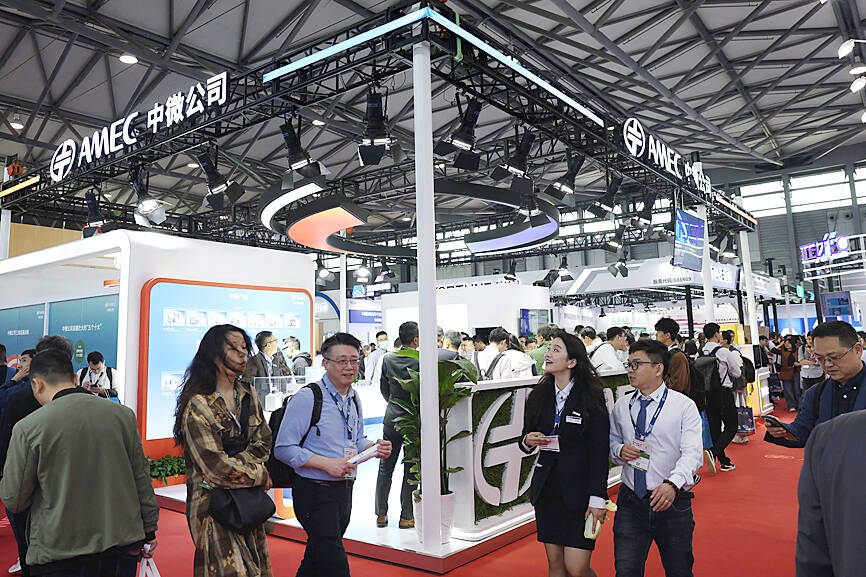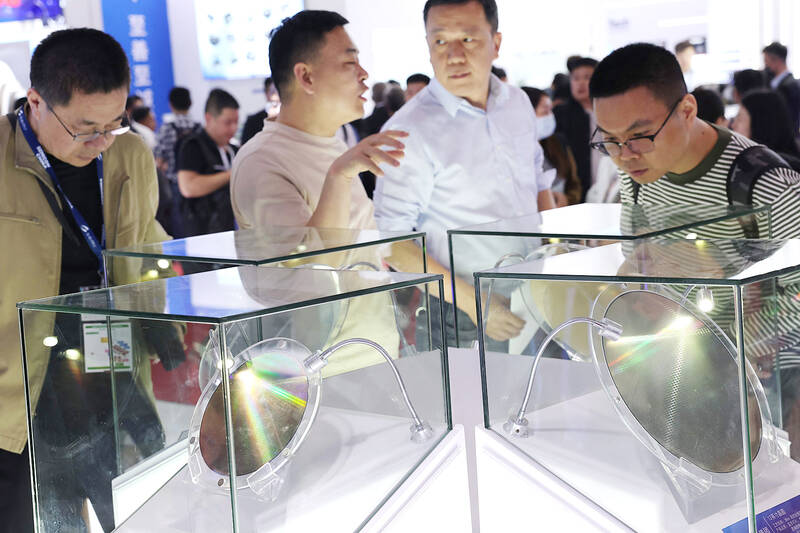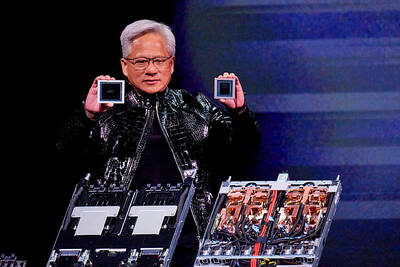China would continue to invest more in new computer chipmaking equipment than any other geographical region this year, despite a significant year-over-year decline, followed by South Korea and Taiwan, industry group SEMI said in a report yesterday.
In its fabrication plant spending forecast, SEMI said global investments in gear would rise 2 percent this year to US$110 billion, the sixth consecutive year in a row of growth, due to investment in tools needed to make chips for artificial intelligence (AI).
The impact of AI would likely be even stronger next year, SEMI added, when investment is expected to grow by another 18 percent.

Photo: AFP
China is the largest consumer of chips, and firms there have been expanding chipmaking capacity for years, but they began a huge sprint in mid-2023 and last year with government support, as part of a drive to lessen dependence on imported chips in response to restrictions imposed by the US government.
ASML Holding NV, the largest chip equipment manufacturer, forecasts sales of 32 billion to 38 billion euros (US$34.5 billion to US$40.9 billion) for this year, implying market share of more than 25 percent for its sub-sector, lithography, where it enjoys a dominant position.
Other top equipment firms include Applied Materials Inc, KLA Corp, LAM Research Corp and Tokyo Electron Ltd, though Chinese equipment makers such as Naura Technology Group Co (北方華創), Advanced Micro-Fabrication Equipment Inc (AMEC, 中微半導體) and Huawei Technologies Co (華為) affiliate SiCarrier Technologies Co (新凱來) are growing fast.

Photo: AFP
Chinese spending is expected to fall to US$38 billion this year, down 24 percent from US$50 billion last year, but still ahead of US$21.5 billion in South Korea, where SK Hynix Inc and Samsung Electronics Co are expanding capacity for memory chips.
Spending in Taiwan, where leading foundry Taiwan Semiconductor Manufacturing Co (台積電) manufactures AI chips for Nvidia Corp and others, is projected at US$21 billion.
Among other regions, the Americas and Japan are each expected to spend US$14 billion this yaer, while Europe would spend US$9 billion, SEMI said.

Nvidia Corp chief executive officer Jensen Huang (黃仁勳) on Monday introduced the company’s latest supercomputer platform, featuring six new chips made by Taiwan Semiconductor Manufacturing Co (TSMC, 台積電), saying that it is now “in full production.” “If Vera Rubin is going to be in time for this year, it must be in production by now, and so, today I can tell you that Vera Rubin is in full production,” Huang said during his keynote speech at CES in Las Vegas. The rollout of six concurrent chips for Vera Rubin — the company’s next-generation artificial intelligence (AI) computing platform — marks a strategic

Enhanced tax credits that have helped reduce the cost of health insurance for the vast majority of US Affordable Care Act enrollees expired on Jan.1, cementing higher health costs for millions of Americans at the start of the new year. Democrats forced a 43-day US government shutdown over the issue. Moderate Republicans called for a solution to save their political aspirations this year. US President Donald Trump floated a way out, only to back off after conservative backlash. In the end, no one’s efforts were enough to save the subsidies before their expiration date. A US House of Representatives vote

REVENUE PERFORMANCE: Cloud and network products, and electronic components saw strong increases, while smart consumer electronics and computing products fell Hon Hai Precision Industry Co (鴻海精密) yesterday posted 26.51 percent quarterly growth in revenue for last quarter to NT$2.6 trillion (US$82.44 billion), the strongest on record for the period and above expectations, but the company forecast a slight revenue dip this quarter due to seasonal factors. On an annual basis, revenue last quarter grew 22.07 percent, the company said. Analysts on average estimated about NT$2.4 trillion increase. Hon Hai, which assembles servers for Nvidia Corp and iPhones for Apple Inc, is expanding its capacity in the US, adding artificial intelligence (AI) server production in Wisconsin and Texas, where it operates established campuses. This

US President Donald Trump on Friday blocked US photonics firm HieFo Corp’s US$3 million acquisition of assets in New Jersey-based aerospace and defense specialist Emcore Corp, citing national security and China-related concerns. In an order released by the White House, Trump said HieFo was “controlled by a citizen of the People’s Republic of China” and that its 2024 acquisition of Emcore’s businesses led the US president to believe that it might “take action that threatens to impair the national security of the United States.” The order did not name the person or detail Trump’s concerns. “The Transaction is hereby prohibited,”